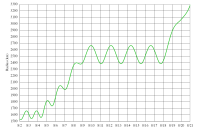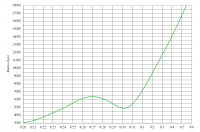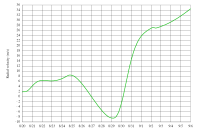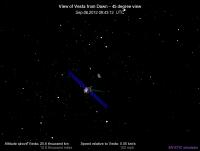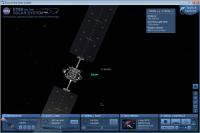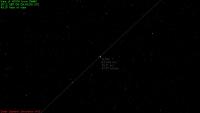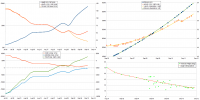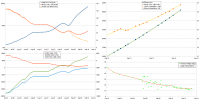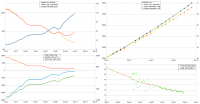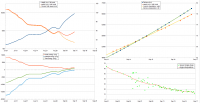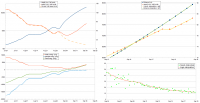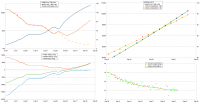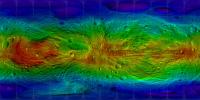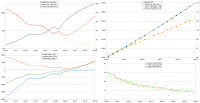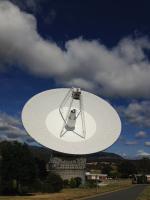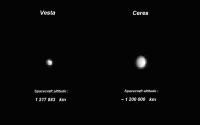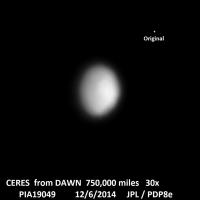Printable Version of Topic
Click here to view this topic in its original format
Unmanned Spaceflight.com _ Dawn _ Vesta departure and journey to Ceres
Posted by: dilo Aug 26 2012, 05:45 AM
As http://www.unmannedspaceflight.com/index.php?s=&showtopic=7112&view=findpost&p=189713 by "TheAnt", is time to start a new thread!
Due to lack of updates from "Mystic simulator", I asked directly to Marc Rayman for an update and he kindly sent me the following "unofficial" plots, showing evolution of distance, radial velocity and sub-spacecraft latitude (radius trend is splitted in two plots with different scales due to huge variation of the distance):
I did not publish them immediately because I wanted to integrate them with my previous plots but, due to the lack of time in last week, I decided to post them directly with only minimal changes.
As you can see, third engine stop occurred on Aug 8-18 at almost 2300km above Vesta while next (final) one is just started and, as reported by Marc in his latest journal, will be used to map North polar regions from 6000km distance. Thereafter thrust will resume and, based on plots, on Sept 5 total speed will overcome escape velocity (almost 45 m/s), so total energy balance will be zero; definitive exit from Vesta Hill sphere should occur after 20 days but consider that the times could slighty change due to orbit refinement and thrust plan changes.
Posted by: Sarunia Aug 26 2012, 11:17 AM
Thanks Dilo for the updating. I was little worried. Last spice spk file (25 august) shows that Dawn will not escape form Vesta indicating an another problem. But it seems now that this file was only a test.
My little contribution with this video created thanks to spice data from NAIF.
http://www.youtube.com/watch?v=EL5nbFU3xl8
Since SPICE doesn't indicate the states of engines, the orbital parameters are only "guessed" assuming a Vesta like a point mass of 2.59^20 kg.
Posted by: tedstryk Aug 26 2012, 05:18 PM
Departure was not supposed to happen until the 26th.
Posted by: Sarunia Aug 26 2012, 11:41 PM
Sorry, I meant the date of spk file releasing (25 august) not the date of depart which is scheduled on 5 september as dilo wrote.
The initial departure was planned on 26 august but after the problem with wheels reaction it was postponed as we know.
But i remain concerned: the last spice ck file shows that the observation of Vesta to mapping north pole didn't occur ![]()
Posted by: Sarunia Aug 27 2012, 06:15 PM
I must apologize for my previous post.
According to the spice files released today, there was an attempt to observe Vesta as planned.
The ck file shows that the probe has problem to maintain her orientation but i don't know if this effect is due to the ck files (always under construction) or the problem of lack of one reaction wheels.
From now, I will avoid any speculations useless alarmist and I will wait the official update of wonderfull Dawn journal and Dilo states plots (specially the states of engine propulsion ![]() ) (from Mystic or Marc).
) (from Mystic or Marc).
And of course hope of beautiful images of Vesta's north pole ![]()
Again very sorry.
Posted by: dilo Aug 28 2012, 04:59 PM
I had a private comunication from Mark, he confirmed that they successfully imaged Vesta over the weekend.
Moreover, he said there wasn't any problem with the SPK file. As explained in several Dawn Journals (including November 29, 2011), they generate a reference trajectory that goes all the way to the next destination but then, as they fly along, they generate updated flight profiles to account for all the usual error sources (orbit determination accuracy, unmodeled perturbations from RCS, deviations in IPS thrust from the modeled value, etc.). Each time an updated thrust plan is sent to the spacecraft, they only send the next thrust segment, not the full reference trajectory; in this way, in case of failure, they don't have onboard ephemeris based on thrusting that didn't occur. So when they upload the new thrust segment, they upload a new ephemeris as well. Probably, SPK issue Sarunia found is for an isolated thrust segment which then is followed by a ballistic propagation...
Posted by: Explorer1 Aug 31 2012, 07:48 AM
A farewell animation:
http://www.youtube.com/watch?v=84vz6J8cnc8
Posted by: TheAnt Aug 31 2012, 08:52 PM
Thank you for posting that one Explorer1.
Next stop Ceres in 2015, so lets find out what that bright spot is then. ![]()
Posted by: Decepticon Sep 1 2012, 04:08 PM
It looks like a peak of a crater to me.
Posted by: Marz Sep 2 2012, 02:39 AM
Looks like an informative Hasta La Vesta hangout:
"We’re celebrating this milestone with http://dawn.jpl.nasa.gov/news/hasta_la_vesta.asp.
During the Hangout, moderated by Dawn’s education and public outreach (E/PO) liaison to the science team, Dr. Britney Schmidt, we’ll hear stories from Dawn scientists and engineers and get updates on latest mission findings.
Pose the questions you’ve always wanted to ask. Submit your questions for the Dawn team by leaving them in the comments section below, on Dawn’s Facebook page, or by using the hashtag #HastaLaVesta on Twitter."
Posted by: dilo Sep 5 2012, 05:00 PM
Based on last Dr Rayman (unofficial) comunication, this morning at 6.45 UT, Dawn definitively leaved Vesta gravitational field when his speed exceeded escape speed (45 m/s at 18000 km height). Curiously, in the same hours http://neo.jpl.nasa.gov/orbits/fullview4.jpg went back online... ![]()
Posted by: belleraphon1 Sep 6 2012, 01:17 AM
A Last Look Back at Vesta ....bye Vesta...
http://dawn.jpl.nasa.gov/feature_stories/dawn_departs_vesta.asp
http://dawn.jpl.nasa.gov/multimedia/last_look_back.asp
From Protoplanet to Dwarf Planet.... Ceres here we come.
Craig
Posted by: Explorer1 Sep 6 2012, 02:40 AM
The pole at last! I'm assuming it's in the largest crater, right?
Posted by: Adam Hurcewicz Sep 6 2012, 08:42 AM
Hi
I see some difference in Dawn - Vesta position at Mystic Simulator and Eyes of the Solar System
Date and time is 9:43 UTC - 06 Sep 2012
See screens below. What's wrong ? What distance are good ?
---------
Added:
In HORIZONS JPL is 64 540 km
http://ssd.jpl.nasa.gov/horizons.cgi
---------
Also in Solar System simulator is 64 549 km
http://space.jpl.nasa.gov
Posted by: dilo Sep 6 2012, 10:27 AM
Adam, I can say Mystic is perfectly in line with Marc Rayman plots, as showed in these plots where I merged the two sources:
(consider that Mystic hiatus ended yesterday and lasted 1 month; moreover, you will not see distance/velocity modulations due to elliptic orbit during third engine stop because I reported only average info in this period).
Moreover, both Marc/Mystic data are in agreement with last Nasa updates about Vesta depart milestone (see links from bellarophon1); in my plots (left/bottom in particular) you can see that total energy becomes positive only on Sptember,5 while, if Dawn really lies at 64500 km from Vesta, this means he surpassed this point many days ago and is already half-way to Vesta Hill sphere margin!
Posted by: Sarunia Sep 6 2012, 07:31 PM
According to the last SPICE kernel (but based on predicted trajectory), Dawn was at 20600 km from Vesta at 9:43 UTC 06 september.
For checking Dawn in real time, Mystic seems to be better than another simulator with extra information that SPICE haven't (like engine status).
I think that the administrators of "Eyes of Solar System" and others just didn't updated the new data.
Dilo, could you ask Marc if the remaining reaction wheels were turned off during the last observation of Vesta ?
Posted by: djellison Sep 6 2012, 08:22 PM
Correct - we just don't have the time.
Posted by: Marz Sep 6 2012, 08:37 PM
Marc just updated his excellent blog:
http://blogs.jpl.nasa.gov/tag/marc-rayman/
So the reaction wheels are nominal and it was simply a programming error that was trying to deactivate them earlier? That is excellent news! C'mon Ceres... are we there yet? [:-p]
Posted by: Floyd Sep 6 2012, 09:05 PM
My reading of Marc's blog didn't indicate things were "nominal" with the reaction wheels--rather that one malfunctioned and all were turned off a week earlier than they were going to turn them off. I believe they started with 3 and 1 backup and have now lost 2. That is not good and will have to be worked around at Ceres when the space craft will need to do lots of turning for imaging and other science. Where did you hear it was an software/programming error rather than a hardware failure?
Posted by: djellison Sep 6 2012, 09:55 PM
In a talk by Marc last week for the EPO folk on lab - he echoed what you describe Floyd. Marz - I think you have things wrong.
Posted by: Marz Sep 6 2012, 10:32 PM
darn! Here's the quote from the blog, with italics around the statement I misinterpreted and bold in the phrase I used to jump to conclusions.
"on August 8 ... one of the reaction wheels experienced an increase in internal friction. ... Protective software quickly detected the event and correctly responded by deactivating that wheel and the other two that were operating, switching to the small jets that are available for the same function, and reconfiguring other systems, including powering off the ion thrust and turning to point the main antenna to Earth.
A routine communications session the next day revealed to mission controllers what had occurred. They had planned long ago to turn the wheels off for the flight from Vesta to Ceres, so having them off a few weeks early was not a significant change. The team soon restored the spacecraft to normal operations and reformulated the departure plan, and on August 17 Dawn resumed its ascent. Because of the hiatus in thrusting, escape shifted from August 26 to September 4. The flexibility in the mission timeline provided by ion propulsion made this delay easy to accommodate."
The next paragraph hints that the reaction wheels are potentially out, since hydrazine is now a precious resource:
"In order to conserve the hydrazine propellant that the jets use, the bonus departure observations described before were curtailed, as they were not a high priority for the mission."
Hopefully we can find out more details on the reaction wheels on the Sept 8th hangout.
Posted by: dilo Sep 8 2012, 10:54 AM
Update on departure progress:
(Note1: I smooted all previous phases in order to show only averaged distance/speed/energy without elliptic-orbit related modulations;
Note2: interpolations in top/right plot are simply 2nd order empiric curves without geometric/gravitational considerations behind).
Posted by: dilo Sep 11 2012, 01:09 PM
I just received some informations from Dr Rayman which shed more light on the reaction wheel issue.
The wheels were all turned off on August 8, when the software detected the increase in friction, and were left off since then, including for the departure observations.
They restored spacecraft to normal operations, but one of "normal operational modes" is to fly with all wheels off (they flew that way from August 2010 to May 2011 and they intend to do so for the journey from Vesta to Ceres). So, "wheels off" is a normal operational mode and future Ceres exploration plan will be based on the use of the two reaction wheel + RCS "hybrid" control capability, installed on the spacecraft in April 2011. Marc highlighted that most of these information were available in previous Dawn journal articles and that he will write more about the reaction wheels, RCS control, hybrid control, and hydrazine in future Dawn Journals (although not the next one).
Herebelow an update on departure plots, showing also a brief engine stop occurred yesterday:
In the bottom/right, I substituted the "Energy ratio" plot with a more interesting plot showing the angle between Vesta-Dawn distance vector and Dawn velocity vector, calculated from total velocity and distance informations in Mystic Simulator (or radial velocity + distance in Marc plots). As you can see, Dawn trajectory is going from a "quasi-orbital" situation (with perpendicular vectors) to a more straightforward escape trajectory (zero angle). The spread of points in the September 5-9 interval is due to the poor precision in calculated distance differences; situation improved when I realized that http://neo.jpl.nasa.gov/orbits/fulltraj.jpg page gives more precise figures...
Posted by: dilo Sep 13 2012, 06:13 AM
Marc confirmed there was a programmed engine stop on September,10 for communication with Earth (they do this each week but probably frequence will be relaxed during the journey to Ceres). Effect is clearly visible in velocity and orientation plots (right):
Based on my interpolations, Dawn should reach Hill sphere border on September,24 around 8:00 UTC, with 140m/s speed.
Posted by: dilo Sep 14 2012, 05:29 PM
Update:
Based on new data points and improved interpolation, Hill sphere crossing date forecast is anticipated to September,23 17:40 UTC, if no further stops will occur...
Posted by: dilo Sep 16 2012, 03:36 PM
Update:
No major changes on Hill sphere crossing date from interpolation; I ran also a simulation using constant engine orientation and thrust (5.1e-5 N/kg) and forecast time is only slightly different (September,23 15:30 UTC)...
Posted by: Explorer1 Sep 16 2012, 05:36 PM
It's amazing how symmetrical Vesta's hemispheres are on the global scale, on this topographic map that includes the far north.
But the northern basin isn't from a giant impact, is it?
http://dawn.jpl.nasa.gov/multimedia/imageoftheday/image.asp?date=20120911
Posted by: dilo Sep 16 2012, 06:51 PM
Explorer1, the northern basin isn't a crater and blue color is due to oblate spheroid shape of Vesta.
In fact, text underline that colors represent distance relative to Vesta's center (or height relative to a sphere with 500km diameter); most important, scale of the two maps isn't the same because lower (violet) points in Northern emisphere are only 22km below such sphere while South depressions reach -38km.
Anyway, the presence of spiral patterns in both polar regions (with opposite orientations) is very intriguing... ![]()
PS: I like very much the Giordano Bruno statement in your signature!
Posted by: dvandorn Sep 16 2012, 07:05 PM
Yes, the spiral patterns resemble, more than anything else, the pattern of modification one sees at Mars' poles. But... Vesta couldn't possibly have ever had enough atmosphere to support ice caps, could it?
-the other Doug
Posted by: algorimancer Sep 17 2012, 01:18 PM
It would be really helpful to have a 3D rendered globe of Vesta -- much would be come clear, I think.
Posted by: chuckclark Sep 17 2012, 03:02 PM
Soon as Phil gives the okay, I'll get started on a fold-up map of the thing.
Phil . . . ?
Posted by: dilo Sep 18 2012, 05:43 PM
Update:
Last engine stop, yesterday, lasted about 9 hours based on speed data; as consequence, Hill sphere exit date shifted slightly ahead (Sep,23 around 20 UTC).
PS: in the last posts, the two left plots (long term range/speed and Energy trends) weren't updated correctly, I'm sorry for this!
Posted by: dilo Sep 21 2012, 11:31 AM
Update:
Final Hill sphere exit date estimation: Sep,23, 19.30 UTC.
Posted by: Phil Stooke Sep 21 2012, 04:03 PM
"Phil . . . ? "
OK Chuck - here I have taken those two polar maps of topography and reprojected them into simple cylindrical. There are a few very minor errors in this composite but nothing to worry you in your work. It should be easy to match this with published gridded maps to get crater names, lat and long etc. (a grid is faintly visible on this, from the originals). But this gives you the topography to locate your ridge lines etc.
PS - apparent mismatch along the equator is caused by different illumination of the rendered shaded relief between the two halves.
Phil
Posted by: dilo Sep 24 2012, 10:55 PM
This is my final update plot of Vesta departure:
Dawn is definitively out of Vesta sphere of influence, exact time depends on which Hill sphere radius you assume. In fact, while http://en.wikipedia.org/wiki/Hill_sphere#Formula_and_examples is based on average distance of the body from Sun, http://adsabs.harvard.edu/abs/1992Icar...96...43H reccomend to use pericenter distance, which gives a smaller radius; moreover, I calculated also the present Hill radius based on current heliocentric distance.
Here below my results, based on interpolation of Mystic simulator distances (sorry for improper use of "code" format but table format appears problematic otherwise!):
Periastron 113180 km Sep, 22 12:40
Average 124180 km Sep, 23 18:52
Current 134750 km Sep, 24 22:30
Posted by: Explorer1 Nov 3 2013, 05:57 PM
New blog post about Ceres cruise:
http://www.planetary.org/blogs/guest-blogs/marc-rayman/20131031-dawn-journal-thrusting-toward-ceres.html
Posted by: Explorer1 Dec 7 2013, 03:39 AM
New info about Ceres plan, with details on hybrid control mode for low-altitude mapping orbit:
http://dawn.jpl.nasa.gov/feature_stories/Dawn_Fills_Out_Ceres_Dance_Card.asp
Posted by: Holder of the Two Leashes Dec 1 2014, 09:51 PM
According to the http://dawnblog.jpl.nasa.gov/2014/11/28/dawn-journal-november-28/, today is the day that Dawn takes its first resolved photos of Ceres, nine pixels across. These are being taken mainly to calibrate the camera. Still a couple of months to go before they start getting the really good stuff.
Posted by: Astro0 Dec 1 2014, 11:34 PM
DSS43 at Canberra DSN is tracking DAWN right now. Not far off sun-point as you can see.
Posted by: Paolo Dec 5 2014, 03:33 PM
the Max Planck Institute has a release (i n German) with the first, distant images of Ceres:
http://www.mps.mpg.de/3867888/PM_2014_12_05_Erster_Blick_auf_eine_neue_Welt
Posted by: Holder of the Two Leashes Dec 5 2014, 03:41 PM
Here is a link to the picture on the Dawn web site: http://dawn.jpl.nasa.gov/feature_stories/Dawn_snaps_image_Ceres.asp
Posted by: SpaceScout Dec 5 2014, 07:25 PM
From the Max Planck release:
"up to today, the sharpest images of Ceres were acquired by HST. Starting end of January 2015, the Framinc Camera images will match and exceed that resolution. From that moment on, we'll enter a new Land."
Posted by: peter59 Dec 6 2014, 10:51 AM
Without a doubt, Ceres is significantly larger than Vesta.
In three or four weeks should start to reveal the first surface details.
Posted by: jgoldader Dec 6 2014, 12:05 PM
This is exciting! ![]() Can't wait to see Ceres close up. Almost looks like albedo differences in the photo, but could just be phase effects.
Can't wait to see Ceres close up. Almost looks like albedo differences in the photo, but could just be phase effects.
Posted by: SFJCody Dec 6 2014, 12:45 PM
Exciting... but in a bittersweet way. This finishes the initial reconnaissance of the rocky terrestrial worlds in our local neighbourhood. If we want fresh terra incognita after this we have to go way, way out to the solar system's frigid fringes.
Posted by: elakdawalla Dec 6 2014, 11:55 PM
I'd like to see Pallas and Hygeia! I want to see how the biggies transition down to the small ones we've seen. Also, while I'm wishing for things, I want much better imaging of Deimos. And heck let's go visit some Trojans too.
Posted by: Explorer1 Dec 7 2014, 12:27 AM
Hektor especially would be a great destination: a contact binary an order of magnitude bigger than 67P and with a moon (always a bonus). We know practically nothing about that region...
Now to wait until the next round of Discovery proposals.
Posted by: charborob Dec 7 2014, 03:00 AM
It would be interesting also to visit a large metallic asteroid.
Posted by: Explorer1 Dec 7 2014, 03:30 AM
Yep, the team proposing a Psyche mission agrees:
http://www.planetary.org/blogs/guest-blogs/van-kane/20140219-mission-to-a-metallic-world.html
Posted by: tedstryk Dec 7 2014, 05:23 PM
Pallas has always seemed particularly interesting as a transitional world.
Posted by: SFJCody Dec 7 2014, 05:57 PM
I'm sure these are all fascinating in their own right. But there's something special about seeing the curving limb of a gravitationally relaxed body- Ganymede, Enceladus, Triton... these all seem like places to me in a way that Vesta never quite did.
When a new planet swims into his ken;
Or like stout Cortez when with eagle eyes
He star'd at the Pacific — and all his men
Look'd at each other with a wild surmise —
Silent, upon a peak in Darien.
Posted by: Explorer1 Dec 10 2014, 08:37 AM
Google Hangout about the Hubble/Dawn imagery comparison coming up:
http://dawn.jpl.nasa.gov/dawncommunity/google_hangout_12_11_2014.asp
It might also be time for a dedicated Ceres approach thread.
Posted by: OWW Dec 10 2014, 01:01 PM
Less than 1 million km now!!! So close!
I'm wondering though, if the ion-thrusters would fail right now, how close would the flyby be? Or could it still limp into orbit by using all the remaining conventional fuel?
And a Ceres prediction thread. Could be fun to see who makes the right prediction. Will the surface look like Tethys? Callisto? Enceladus?
Posted by: Explorer1 Dec 10 2014, 05:18 PM
I'd say Callisto or Mimas, just keeping expectations low (i.e. completely saturated with craters). That way everything else can be a pleasant surprise.
Posted by: Superstring Dec 12 2014, 11:42 PM
Its density is comparable to Ganymede and Callisto, but it's also warmer -- warmer than any icy moon. Plus we know there's some water vapor around it (outgassing? sublimation?) and that the surface is dark. So I think it could be quite a unique world even if it's not geologically active.
Posted by: antipode Dec 13 2014, 04:49 AM
There was a paper published last year, in Icarus I think, that suggested the warmer surface of Ceres compared to the outer moons might result in VERY subdued crater topography (really all but small and fresh craters slump over geological time until they become mere albedo features) except right near the colder poles. So, even if its geologically 'boring', (and I hope it isnt!), I doubt Ceres is going to look like Callisto or Mimas.
P
Posted by: Mithridates Dec 13 2014, 04:33 PM
The planetoid I want to see the most next is 24 Themis:
http://en.wikipedia.org/wiki/24_Themis
In a similar location to Ceres, 200 km in diameter, a surface with lots of water ice, and most importantly:
Inclination 0.7595°
So it orbits on exactly the same orbital plane as us. Very rare for an object of its type.
Posted by: djellison Dec 13 2014, 06:17 PM
So it orbits on exactly the same orbital plane as us. Very rare for an object of its type.
The Earth's orbital inclination is zero. Changing inclination to 0.76 degrees would require a delta V of about 0.4km/sec
Posted by: Explorer1 Dec 13 2014, 07:05 PM
Huh, that's a tiny fraction of the tilt of Vesta and Ceres; its even smaller than Mars and Venus.
So many tempting targets out there for future missions (Dawn 2 anyone?).
Posted by: jgoldader Dec 13 2014, 08:48 PM
I would love to see a series of smallsats sent to asteroids. If successful, the Procyon satellite launched with Hayabusa-2 might encourage such missions. Imagine using a large booster to put dozens of these into the asteroid belt at the same time...
Posted by: djellison Dec 14 2014, 06:43 AM
But it certainly is not 'exactly the same orbital plane as us'
Posted by: katodomo Dec 14 2014, 10:34 AM
Where they'd die for lack of sun unless you seriously enlarge them to fit some halfway decent panels on them
Posted by: Paolo Dec 14 2014, 10:44 AM
at which heliocentric distance? IIRC, the delta-V for plane change(for a solar orbit) depends on the heliocentri distance
Posted by: TheAnt Dec 14 2014, 02:51 PM
Indeed it does, lets say we are to launch one dedicated mission to study Pallas, the best idea would to launch the spacecraft at an inclined orbit around the Earth of 34.8° from the very start, and then to send it on its way with the upper stage.
So as for expectations, I came to the same conclusion as antipode, without having read the paper in question.
Meaning that with the relatively high daytime temperature I expect Ceres to be a quite flat around the equator, but with a bit more topography, more distinct crater rims etc, toward the poles. And with brighter poles, from hoarfrost that have settled there.
Posted by: PDP8E Jan 4 2015, 02:00 AM
While we wait for DAWN to snap more approach images of Ceres, I put the Dec 2014 Framing Camera image (PIA19049) through the deconvolution process. I hate going above 10x on an image, since we are pushing around noise, point spread functions of the camera, and other artifacts (such as working from a JPEG). But I ran this baby up to the max: 30x (!)
Don't try to see craters or such things other than a bright area on the right side (and a slightly darker 'depression' on the lower right --to be named the pdp8e abyss ![]() ). Most of the image is the deconvolver 'hallucinating' about what it thinks it sees... but it is fun!
). Most of the image is the deconvolver 'hallucinating' about what it thinks it sees... but it is fun!
The size difference (not resolution) is about what Ceres would appear at roughly 25,000 miles away
Posted by: TheAnt Jan 4 2015, 10:27 PM
@PDP8E: Yes it is really to early to see anything on Ceres yet.
But keep it up and in a little over a month we might get to see the first detail.
Hubble images have hinted there is at least one surface feature that could be spotted even at the early approach.
Now craters, if our current thinking is correct Ceres got a dusting of material on top, so larger (and more recent) craters might have a bright bottom.
While I am at it, I am quite pessimistic on the outlook to find any satellite at Ceres for the same reason, any impact that might have sent material into orbit will be mostly be ice and might sublimate before it have time to coalescence, (which might be how the smaller satellites of Pluto came to be in that much colder environment.)
There could be a very small rock in orbit, as for example one component of a binary asteroid that been captured and the small size made it escape detection in telescopic searches.
Posted by: katodomo Jan 5 2015, 12:42 AM
"Very small rock" is a relative term - e.g. in http://www.helsinki.fi/acm2014/pdf-material/Day-5/Session-2/Room-1/SCHMIDT-91FC.pdf the detection limit mentioned for various searches of Ceres' inner Hill Sphere is somewhere around 1-2 km at 4000 km, possibly bigger further in. And since Ceres' Roche limit even for the most porous of rubble piles is well below 2000 km...
Posted by: TheAnt Jan 5 2015, 02:29 AM
Yes "relative" is the word, I were aware of those searches mentioned in the paper and with a size of just one km or two it could be more suitable to name it 'rock' here than Moon which usually make people think of a more substantial object. =)
But yes it could be somewhat larger, especially if it is exceptionally dark.
Posted by: mcgyver Mar 12 2015, 12:58 PM
Shouldn't this thread be closed now that Ceres finished its journey?
We are now talking about orbiting Ceres: http://www.unmannedspaceflight.com/index.php?showtopic=7981&st=0&#entry218672
Powered by Invision Power Board (http://www.invisionboard.com)
© Invision Power Services (http://www.invisionpower.com)
